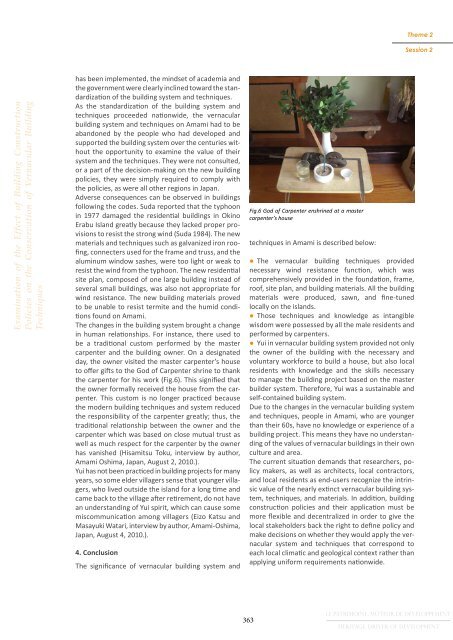PARTIE 2 - Icomos
PARTIE 2 - Icomos
PARTIE 2 - Icomos
You also want an ePaper? Increase the reach of your titles
YUMPU automatically turns print PDFs into web optimized ePapers that Google loves.
Theme 2<br />
Session 2<br />
Examination of the Effect of Building Construction<br />
Policies on the Conservation of Vernacular Building<br />
Techniques<br />
has been implemented, the mindset of academia and<br />
the government were clearly inclined toward the standardization<br />
of the building system and techniques.<br />
As the standardization of the building system and<br />
techniques proceeded nationwide, the vernacular<br />
building system and techniques on Amami had to be<br />
abandoned by the people who had developed and<br />
supported the building system over the centuries without<br />
the opportunity to examine the value of their<br />
system and the techniques. They were not consulted,<br />
or a part of the decision-making on the new building<br />
policies, they were simply required to comply with<br />
the policies, as were all other regions in Japan.<br />
Adverse consequences can be observed in buildings<br />
following the codes. Suda reported that the typhoon<br />
in 1977 damaged the residential buildings in Okino<br />
Erabu Island greatly because they lacked proper provisions<br />
to resist the strong wind (Suda 1984). The new<br />
materials and techniques such as galvanized iron roofing,<br />
connecters used for the frame and truss, and the<br />
aluminum window sashes, were too light or weak to<br />
resist the wind from the typhoon. The new residential<br />
site plan, composed of one large building instead of<br />
several small buildings, was also not appropriate for<br />
wind resistance. The new building materials proved<br />
to be unable to resist termite and the humid conditions<br />
found on Amami.<br />
The changes in the building system brought a change<br />
in human relationships. For instance, there used to<br />
be a traditional custom performed by the master<br />
carpenter and the building owner. On a designated<br />
day, the owner visited the master carpenter’s house<br />
to offer gifts to the God of Carpenter shrine to thank<br />
the carpenter for his work (Fig.6). This signified that<br />
the owner formally received the house from the carpenter.<br />
This custom is no longer practiced because<br />
the modern building techniques and system reduced<br />
the responsibility of the carpenter greatly; thus, the<br />
traditional relationship between the owner and the<br />
carpenter which was based on close mutual trust as<br />
well as much respect for the carpenter by the owner<br />
has vanished (Hisamitsu Toku, interview by author,<br />
Amami Oshima, Japan, August 2, 2010.).<br />
Yui has not been practiced in building projects for many<br />
years, so some elder villagers sense that younger villagers,<br />
who lived outside the island for a long time and<br />
came back to the village after retirement, do not have<br />
an understanding of Yui spirit, which can cause some<br />
miscommunication among villagers (Eizo Katsu and<br />
Masayuki Watari, interview by author, Amami-Oshima,<br />
Japan, August 4, 2010.).<br />
4. Conclusion<br />
The significance of vernacular building system and<br />
Fig.6 God God of Carpenter of Carpenter enshrined enshrined at a master at a master<br />
carpenter’s house house<br />
techniques in Amami is described below:<br />
●●<br />
The vernacular building techniques provided<br />
necessary wind resistance function, which was<br />
comprehensively provided in the foundation, frame,<br />
roof, site plan, and building materials. All the building<br />
materials were produced, sawn, and fine-tuned<br />
locally on the islands.<br />
●●<br />
Those techniques and knowledge as intangible<br />
wisdom were possessed by all the male residents and<br />
performed by carpenters.<br />
●●<br />
Yui in vernacular building system provided not only<br />
the owner of the building with the necessary and<br />
voluntary workforce to build a house, but also local<br />
residents with knowledge and the skills necessary<br />
to manage the building project based on the master<br />
builder system. Therefore, Yui was a sustainable and<br />
self-contained building system.<br />
Due to the changes in the vernacular building system<br />
and techniques, people in Amami, who are younger<br />
than their 60s, have no knowledge or experience of a<br />
building project. This means they have no understanding<br />
of the values of vernacular buildings in their own<br />
culture and area.<br />
The current situation demands that researchers, policy<br />
makers, as well as architects, local contractors,<br />
and local residents as end-users recognize the intrinsic<br />
value of the nearly extinct vernacular building system,<br />
techniques, and materials. In addition, building<br />
construction policies and their application must be<br />
more flexible and decentralized in order to give the<br />
local stakeholders back the right to define policy and<br />
make decisions on whether they would apply the vernacular<br />
system and techniques that correspond to<br />
each local climatic and geological context rather than<br />
applying uniform requirements nationwide.<br />
363<br />
LE PATRIMOINE, MOTEUR DE DÉVELOPPEMENT<br />
HERITAGE, DRIVER OF DEVELOPMENT

















